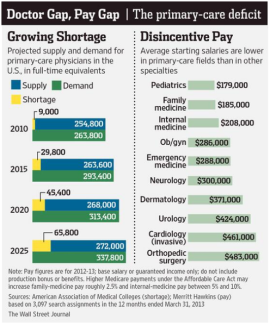Long-Term Care: The Economic Reality
When you woke up this morning, 10,000 Baby Boomers just turned 65.....and this will continue to occur every day for about the next 18 years. As Boomer age, roughly 70% will experience the need for Long-Term Care at some point in their lives. The degree and duration for which they’ll need care will vary, however the sheer size of this group will significantly impact the delivery of Long-Term Care services, and the Economics of the healthcare industry as a whole.
Healthcare and An Aging America.....
According to Ken Dychtwald, president and CEO of the consulting firm AgeWave, "anyone who thinks the boomers will turn 65 and be the same as the generation before are missing out on the last 60 years of sociology. The boomers change every stage of life through which they migrate. We weren't prepared for the boomers. There weren’t enough hospitals or pediatricians. There weren’t enough bedrooms in our homes. There weren't enough schoolteachers or textbooks or playgrounds. The huge size of this generation has strained institutions every step of the way."
Its clear Boomers will have a significant impact on the healthcare system; especially once it's understood how and where their care will likely be provided. While it's difficult to simplify this complex topic, we'll try to do so by looking at three aspects of the healthcare system: Physicians, Home Health Care and Facility-Based Care.
Doctors Understand Economics 101.....
In the not-so-distant future, demand for healthcare (and Long-Term Care services) may very well outstrip available supply; regardless of who provides care or where it's provided. No matter how Washington D.C. tweaks Medicare and Medicaid, or somehow manages to implement Obamacare, healthcare providers won't necessarily choose to participate if the economics of doing so don't make sense.
Unfortunately, there's no easy way (sigh…) our politicians can or will effectively address issues with Medicare/Medicaid. Even if changes are made, government cannot simply legislate its way around the laws of supply and demand; avoiding the economic reality that supply-side issues will then dictate price and/or availability. With respect to Medicare and Medicaid, many healthcare providers will embrace basic economic reality: Doctors & Facilities have the ability to “opt out” of providing care under the reimbursement terms of government programs.
It's beginning to happen already.....
A recent BusinessWeek article highlights the trend of healthcare providers creating “concierge” practices. “There aren’t enough primary-care people around now,” says Arthur Caplan, director of medical ethics at the NYU Langone Medical Center. “When concierge practices spread, that means more and more people will be left without any access to primary care.”
Furthermore, by 2020, the Association of American Medical Colleges estimates, there will be 45,000 fewer primary-care doctors than the U.S. needs. “For the last 13 years, very few students have been going into it,” says Patrick Dowling, chairman of the department of family medicine at the University of California-Los Angeles’s David Geffen School of Medicine.
Based on supply and demand, Americans may be forced to re-evaluate their expectations as to how healthcare is delivered. And, if the delivery of healthcare - through primary-care physicians - evolves as BusinessWeek details, the landscape may change throughout the healthcare system. This could, and likely will, have a direct effect on the delivery and availability of Long-Term Care services as well.
Home Health Care - Maintaining Independence & Choice....
Americans love having choices.....where we travel, what we eat, how we entertain ourselves, etc. We are also very selective with respect to our healthcare. Even if you dismiss future shortages of physicians, or the potential for a two-tiered delivery system of healthcare, it’s impossible to ignore the fact that every American has a desire to age gracefully and independently – and in their own familiar surroundings.
This means home based and/or community based care will continue to become more prevalent. As such, there will be a substantial increase in the demand for companies providing care in this manner. Once again, increasing demand will likely impact cost and/or availability of care.....
According to the University of California, Center for California Health Workforce Studies, “there are shortages in the nation’s health workforce, particularly among nurses, nursing assistants, home care aides, and personal care workers” and “it is important to understand the relationship between the demand for services, the settings in which services will be delivered, and the workforce needed to provide those services.”
In a much more direct way, Shawn Rimerman, Owner of ComForcare Senior Services in St. Louis, illustrates the problem we face. According to Shawn, “we go to great lengths to screen our caregivers and finding the right people to work for us, who 1) can care for our clients in the way we expect; and 2) who will do so under today’s economic model is a huge challenge. The demand and the marketplace dictate what we can charge for those services, and simply put, our biggest cost is paying our caregivers a fair hourly rate. As the aging of our population continues, the onus will fall on individuals and families to meet their needs for Long-Term Care services. Realistically, the financial burden of doing so without having to deplete one's life savings cannot be met through any current or potential government program.”
Facility-Based Care: The Good, The Bad & The Ugly....
Most people who need medical attention or Long-Term Care services try to avoid facility-based care. Unfortunately, because of certain "flaws" with Medicare and Medicaid reimbursement, neither program allows for much flexibility, and facility-based care becomes the norm. This is NOT what the patient wants, and it's very expensive for the system overall.
For example, I recently met with an advisor and his client, and she described a situation where her husband was recovering from a recent surgery, however infections developed during recovery. Her husband was forced to move to a Long-Term Care facility; where he spent 30 days receiving drug therapy to fight the infections. The only service provided by the facility was a daily visit by a nurse to re-fill the intravenous solution containing the medication. In this instance, Medicare could have saved more than $6,000, had the treatment been allowed in their home, and administered by a private-duty nurse.....and this is happening all around the country!!
Today, government programs enforce out-dated restrictions defining what care can and cannot be provided outside of a medical facility. The lack of cost containment dramatically affects the cumulative cost of healthcare through these programs overall. Tomorrow, another 10,000 Boomers turn 65 and this problem will continue to grow....
The Kaiser Family Foundation, a non-profit foundation, focusing on the major health care issues facing the U.S, compiles a variety of statistics annually. When you analyze some of the figures, they highlight a somewhat nightmarish scenario. Consider the following statistics:
- There are total of 15,622 Nursing Facilities in the United States.
- The total beds in those facilities equal 1,663,445.
- The occupancy rate for those facilities is currently 83.3%.
- The primary payer for 63% of the residents is currently Medicaid.
- Of the 15,622 facilities, 68% operated on a "for-profit" basis.
- Based on current occupancy, this leaves just 300,000 beds "available" today.
Taken at face value, these statistics paint a grim picture....Now combine them with the government's Medicare estimates that by 2020 there will be roughly 20 million people accessing some form of Long-Term Care services.
Maybe Morningstar's estimates are wrong and 40% of those over age 65 WON'T require Facility-Based care at some point in their life, and 10% of those individuals WON'T require care for 5 year or more. If Morningstar's estimates are even partially accurate, simple math tells you by 2020 the country will be in need of approximately 500,000 additional beds.
At that point, it won't matter what government programs cover if the 68% of "for-profit" facilities simply choose not participate.....and that's the potential of the Economic Reality of Long-Term Care.
Dan McGrath, Director of Institutional Marketing at Zenith Marketing Group sums up the situation, saying Long-Term Care Planning "is no longer about protecting assets in retirement; it has become the best negotiating chip one can have to access care in retirement".
Hopefully, you will take a more pragmatic view of the future delivery of healthcare and Long-Term Care services. I encourage you to embrace the fact that the basic law of supply & demand will likely have far greater impact on the cost, choice and availability of healthcare, than most people realize today.



